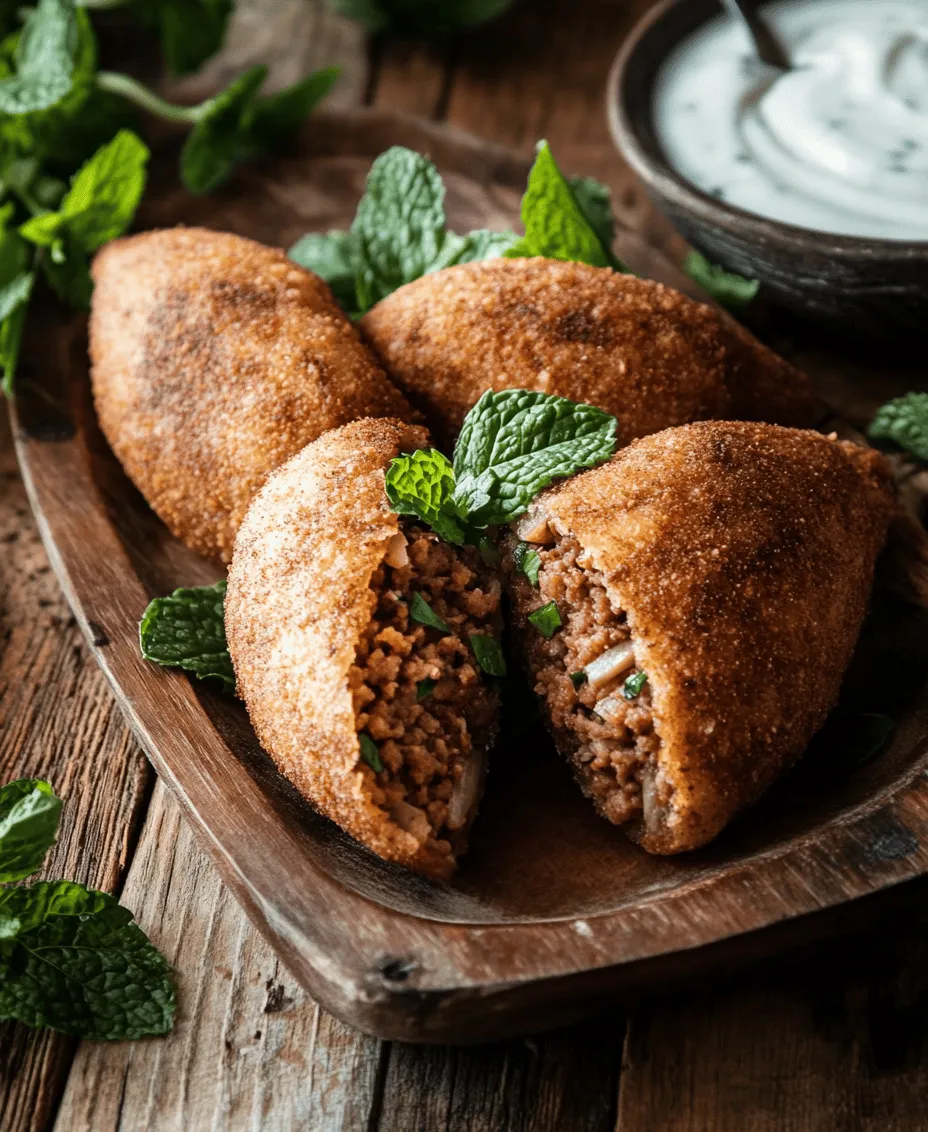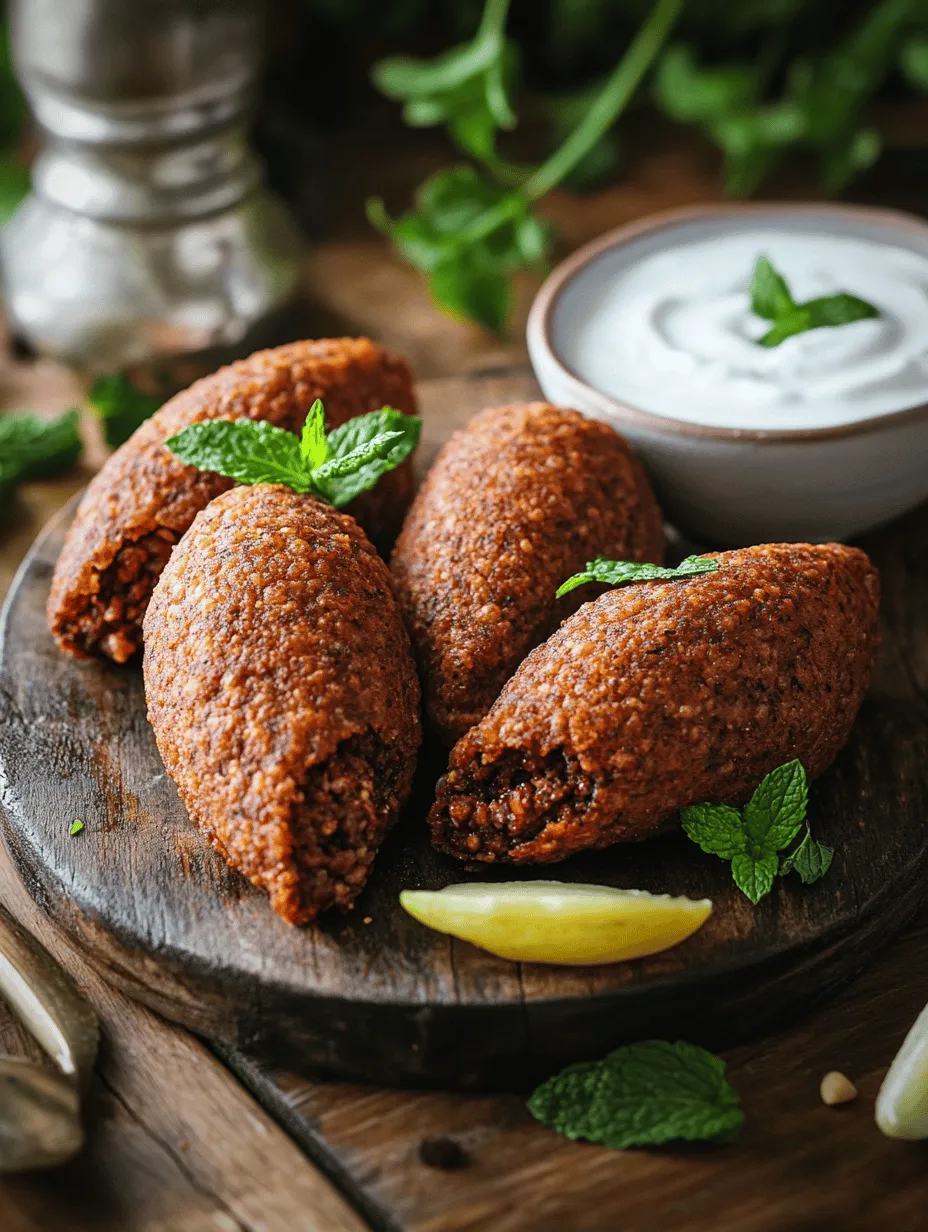Kibbeh is a beloved dish that holds a special place in the heart of Middle Eastern cuisine, celebrated for its distinctive combination of flavors and textures. This dish transcends mere sustenance; it embodies the essence of tradition, family gatherings, and cultural heritage. As we embark on this culinary journey, we will delve into the art of crafting Irresistible Spiced Kibbeh, a dish that marries the rich taste of ground lamb or beef with aromatic spices and a satisfying crunch from toasted pine nuts.
Whether served as an appetizer, main course, or part of a mezze platter, Kibbeh has captured the hearts—and palates—of food lovers around the world. Its versatile nature allows for various interpretations, yet the classic version remains a staple in many households. In this article, we will explore the ingredients, preparation methods, and serving suggestions that make this dish a true standout.
Understanding the Essence of Kibbeh
The History and Cultural Significance of Kibbeh
Kibbeh’s origins trace back to ancient times, with roots deeply embedded in the Levantine region, particularly in countries such as Lebanon, Syria, and Palestine. It is widely believed that Kibbeh was invented by the nomadic tribes of the region, who sought to make their meat last longer and easier to transport. Over the centuries, Kibbeh evolved, incorporating various spices, grains, and cooking techniques that reflect the cultural influences of each region.
Kibbeh is not just a dish; it is a symbol of hospitality and generosity in Middle Eastern culture. Traditionally served during festive occasions and family gatherings, Kibbeh represents the communal spirit of sharing and celebrating life’s moments. It has also adapted to regional variations, from the fried and baked versions to the raw preparations, showcasing the dish’s versatility and the creativity of home cooks and chefs alike.
Key Ingredients that Make Kibbeh Unique
At the heart of Kibbeh lies a harmonious blend of ingredients that contribute to its rich flavor profile. The main components include:
– Bulgur Wheat: This cracked wheat is the backbone of the Kibbeh shell. Its nutty flavor and chewy texture provide the perfect base for the dish.
– Ground Meat: While lamb is the traditional choice for Kibbeh, beef is also commonly used. The selection of meat greatly influences the overall flavor and richness of the final product.
– Spices: A signature blend of spices such as cinnamon, allspice, and nutmeg adds depth and warmth to the dish. Fresh herbs like parsley and mint often enhance the flavor profile.
– Pine Nuts: Toasted pine nuts provide a delightful crunch and a hint of sweetness, creating a balance with the savory elements of the Kibbeh.
Understanding these ingredients is crucial to fully appreciating the artistry of Kibbeh making. Each component plays a role in crafting the perfect bite and elevating the dish to new culinary heights.
Preparing the Kibbeh Shell
Selecting the Right Type of Bulgur Wheat
When it comes to making Kibbeh, the type of bulgur wheat you choose is critical. Fine bulgur wheat, which is made from whole grains that have been cracked and partially cooked, is the preferred choice for Kibbeh. Its fine texture allows for a smooth and cohesive mixture when combined with ground meat, ensuring that the shell holds together during cooking.
Coarse bulgur, while suitable for other dishes, lacks the finesse needed for Kibbeh, leading to a crumbly texture that can compromise the overall integrity of the dish. Therefore, always opt for fine bulgur when embarking on your Kibbeh-making adventure, as it will significantly affect the final result.
Soaking and Preparing the Bulgur
The preparation of bulgur is a straightforward yet crucial step in the Kibbeh-making process. Here’s how to properly soak, drain, and prepare your bulgur for the Kibbeh shell:
1. Measure the Bulgur: Start by measuring the amount of fine bulgur wheat needed for your recipe. Typically, one cup of bulgur will suffice for a standard batch of Kibbeh.
2. Rinse the Bulgur: Place the bulgur in a fine-mesh strainer and rinse it under cold water to remove any impurities. This step ensures that your Kibbeh is clean and free from any residual debris.
3. Soak the Bulgur: Transfer the rinsed bulgur to a bowl and cover it with water. Allow it to soak for about 30 minutes, or until the grains have absorbed the water and softened. This soaking process is essential, as it plumps the bulgur and makes it easier to work with.
4. Drain and Squeeze: After soaking, drain the bulgur in the fine-mesh strainer again, pressing it gently to remove excess moisture. This step is vital to achieving the right texture in your Kibbeh shell; too much moisture can lead to a soggy result.
5. Fluff the Bulgur: Once drained, transfer the bulgur to a clean bowl and fluff it with a fork to separate the grains. This will ensure an even distribution when mixed with the other ingredients.
Creating the Kibbeh Mixture
Now that your bulgur is prepared, it’s time to create the Kibbeh mixture. This step involves combining the bulgur with ground meat, spices, and herbs to form a cohesive blend. Follow these step-by-step instructions:
1. Combine Ingredients: In a large mixing bowl, combine the soaked and drained bulgur with your choice of ground meat (lamb or beef), finely chopped onions, and an array of spices such as salt, pepper, allspice, and cinnamon.
2. Add Fresh Herbs: Incorporate chopped fresh parsley and mint into the mixture. These herbs not only enhance the flavor but also add a vibrant color to your Kibbeh.
3. Incorporate Fat: For an extra layer of flavor and moisture, consider adding a small amount of olive oil or melted clarified butter to the mixture. This will help bind the ingredients together and add richness.
4. Mix Thoroughly: Using your hands, mix the ingredients thoroughly until well combined. The goal is to achieve a uniform mixture where the bulgur, meat, spices, and herbs are evenly distributed. This will ensure that every bite of Kibbeh is bursting with flavor.
5. Test the Mixture: Before proceeding to shape the Kibbeh, it’s a good idea to cook a small patty of the mixture to taste. This will help you adjust seasoning if necessary, ensuring your final product is perfectly seasoned.
Crafting the Filling
The filling is what truly elevates Kibbeh from a simple dish to an extraordinary culinary experience. The combination of sautéed meat, onions, spices, and nuts creates a savory center that contrasts beautifully with the spiced bulgur shell. Here’s how to craft the perfect filling:
Choosing the Perfect Ground Meat
When it comes to the choice of ground meat for your Kibbeh filling, both lamb and beef have their merits. Lamb is traditionally favored for its rich, robust flavor, which pairs wonderfully with the spices used in Kibbeh. If you opt for lamb, aim for a blend that contains some fat, as this will contribute to the juiciness of the filling.
On the other hand, beef is a more accessible option and can also yield a delicious result. When using beef, choose ground chuck or a blend that contains a reasonable fat content to avoid a dry filling. Ultimately, your choice of meat will depend on personal preference and availability.
Sautéing the Onion and Meat
Sautéing the onion and meat is a crucial step in developing the flavors of your Kibbeh filling. Here’s how to achieve the perfect caramelization:
1. Heat the Pan: In a large skillet, heat a tablespoon of olive oil over medium heat. Once the oil is shimmering, add finely chopped onions.
2. Sauté the Onions: Cook the onions for about 5-7 minutes until they become translucent and start to caramelize. This step is essential, as caramelized onions add a depth of flavor that enhances the overall filling.
3. Add the Ground Meat: Once the onions are ready, add the ground meat to the skillet. Use a wooden spoon to break up the meat as it cooks, ensuring it browns evenly.
4. Season the Mixture: As the meat begins to brown, season it with salt, pepper, and your choice of spices. Common additions include allspice, cumin, and a hint of cinnamon. Allow the mixture to cook until the meat is fully browned and cooked through.
5. Stir in Nuts: For added texture and flavor, stir in toasted pine nuts or walnuts during the last few minutes of cooking. These nuts will provide a delightful crunch that contrasts beautifully with the tender meat and bulgur.
6. Cool the Filling: Once the filling is fully cooked, remove it from the heat and allow it to cool slightly before assembling the Kibbeh. This will make it easier to handle and prevent the mixture from cooking the bulgur shell prematurely when assembled.
In the next part of this article, we will continue our exploration of crafting Irresistible Spiced Kibbeh by discussing the shaping process, cooking methods, and serving suggestions that will make your Kibbeh a culinary triumph. Stay tuned as we unlock the secrets to creating this delicious Middle Eastern classic!

Highlighting the Role of Spices and Toasted Pine Nuts in Enhancing the Filling’s Flavor Profile
The star of Irresistible Spiced Kibbeh is undoubtedly the filling, where the magic of spices and toasted pine nuts comes into play. Traditional kibbeh is all about balancing flavors, and the right blend of spices can transform a simple dish into an extraordinary culinary experience. Common spices used in kibbeh filling include cinnamon, allspice, and nutmeg, each contributing its unique essence. Cinnamon adds warmth, while allspice introduces a hint of sweetness and complexity. Nutmeg, with its earthy undertones, rounds out the profile beautifully.
Toasted pine nuts are another key ingredient that elevates the dish, providing a delightful crunch and a rich, buttery flavor. When toasted, they release their natural oils, intensifying their taste and adding depth to the filling. Incorporating these elements not only enhances the filling’s flavor but also enriches the overall texture of the kibbeh, making each bite a wonderful experience.
Assembling the Kibbeh
Techniques for Shaping Kibbeh
Shaping the kibbeh is both an art and a science. Begin with the dough, which should be smooth and pliable, making it easier to mold into shapes. Take a small amount of dough, roughly the size of a golf ball, and press it into the palm of your hand to create a small cup.
To form the kibbeh balls, place your thumb in the center of the cup and press down gently while rotating the dough to create a hollow shell. The aim is to make the walls of the kibbeh about a quarter-inch thick. This thickness is crucial; too thin, and they may break open during cooking, while too thick can lead to a chewy texture.
Filling and Sealing the Kibbeh
Once you have your hollow shell, it’s time to add the filling. Spoon a generous amount of the spiced meat mixture into the center, ensuring not to overfill, as this can lead to a messy outcome. Carefully pinch the edges of the kibbeh shell together to seal it. Make sure to press firmly but gently to ensure the filling is securely enclosed.
After sealing, smooth out the surface of the kibbeh with your fingers to create a uniform shape. For traditional kibbeh, you can use a fork to create decorative ridges on the surface or simply leave them smooth for a more rustic look.
Cooking Methods for Kibbeh
Frying Kibbeh to Perfection
Frying is the most popular cooking method for kibbeh, producing a crispy exterior that contrasts beautifully with the tender filling. Begin by heating oil in a deep skillet or fryer to about 350°F (175°C). To test if the oil is ready, drop a small piece of dough into the oil; if it sizzles and rises to the surface, you’re good to go.
Carefully place the kibbeh in the hot oil, ensuring not to overcrowd the pan, which can lower the oil’s temperature. Fry the kibbeh for about 5-7 minutes, turning occasionally, until they are golden brown and crispy. Once cooked, remove them with a slotted spoon and drain on paper towels to absorb excess oil.
Baking Kibbeh for a Healthier Option
For those seeking a healthier alternative, baking kibbeh is an excellent option. Preheat your oven to 375°F (190°C). Arrange the filled kibbeh on a baking sheet lined with parchment paper. Brush the top of each kibbeh lightly with olive oil to promote browning and add flavor.
Bake in the preheated oven for about 30-35 minutes or until they are golden and firm to the touch. Baking allows the flavors to meld beautifully while keeping the dish lighter, making it a fantastic choice for gatherings or everyday meals.
Grilling Kibbeh for Smoky Flavor
Grilling kibbeh adds a unique smokiness that enhances the overall flavor profile. Preheat your grill to medium-high heat. If using skewers, thread the kibbeh onto soaked wooden skewers or metal skewers, ensuring they are tightly packed to prevent them from falling apart.
Grill the kibbeh for about 10-12 minutes, turning frequently, until they have nice grill marks and are cooked through. The high heat of the grill caramelizes the exterior, creating an irresistible crust while keeping the filling juicy and flavorful.
Serving Your Irresistible Spiced Kibbeh
Presentation Ideas for a Stunning Platter
When it comes to serving your kibbeh, presentation can make a significant impact. Arrange the kibbeh on a large serving platter, garnished with fresh herbs like parsley or mint for a pop of color. You can also add lemon wedges around the platter for a refreshing touch. Consider drizzling a little olive oil over the kibbeh or serving them with a side of tahini sauce for added flavor.
Another creative idea is to serve kibbeh in individual portions, either on small plates or in a bento-style box, accompanied by a colorful salad. This not only makes for an appealing presentation but also allows guests to enjoy a variety of flavors in one meal.
Pairing Suggestions for the Perfect Meal
Kibbeh is versatile and pairs well with numerous side dishes and sauces. A refreshing tabbouleh salad made with parsley, tomatoes, and bulgur wheat complements the flavors of the kibbeh beautifully. Additionally, serving a yogurt sauce or tahini sauce on the side can enhance the dish, providing a creamy texture that balances the spices.
For a complete meal, consider serving your kibbeh with fragrant saffron rice or a side of roasted vegetables. These options not only enhance the meal’s nutritional value but also create a colorful and enticing dining experience.
Conclusion: The Delight of Homemade Kibbeh
Making Irresistible Spiced Kibbeh from scratch is a rewarding culinary journey that brings the rich traditions of Middle Eastern cuisine to your kitchen. The combination of aromatic spices, hearty fillings, and various cooking methods allows for a personalized touch, ensuring that each batch of kibbeh is unique.
The satisfaction of creating this beloved dish, whether for a family gathering or a festive occasion, cannot be overstated. Kibbeh not only showcases your culinary skills but also serves as a bridge, bringing friends and family together to enjoy a shared experience. With its rich flavors and inviting aroma, kibbeh is sure to leave a lasting impression on all who taste it, making every meal a celebration of good food and togetherness.



